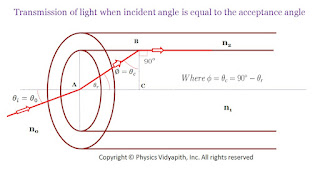Vector Form of Coulomb's Law
Derivation of vector form of Coulomb's law:
Let us consider, Two-point charges $+q_{1}$ and $+q_{2}$ are separated at a distance $r$ (magnitude only) in a vacuum as shown in the figure given below.
Let $\overrightarrow{F_{12}}$ is the force on charge $+q_{1}$ due to charge $+q_{2}$ and $\overrightarrow{F_{21}}$ is the force on charge $+q_{2}$ due to charge $+q_{1}$. Then
$\overrightarrow{F_{12}}=\frac{1}{4\pi \varepsilon _{0}}\frac{q_{1}q_{2}}{r^2}\:\:\hat{r_{21}}\qquad(1)$
Where $\widehat{r}_{21}$ ➝ Unit Vector Pointing from charge $+q_{2}$ to charge $+q_{1}$
$\overrightarrow{F_{21}}=\frac{1}{4\pi \varepsilon _{0}}\frac{q_{1}q_{2}}{r^2}\:\:\hat{r_{12}}\qquad(2)$
Where$\widehat{r}_{12}$ ➝ Unit Vector Pointing from charge $+q_{1}$ to charge $+q_{2}$
From the above figure, we can conclude that the direction of unit vector $\widehat{r}_{12}$ and $\widehat{r}_{21}$ is opposite. i.e.
$\hat{r_{12}}=-\hat{r_{21}}\qquad(3)$
So from equation $(2)$ and equation $(3)$, we can write as
$\overrightarrow{F_{21}}=-\frac{1}{4\pi \varepsilon _{0}}\frac{q_{1}q_{2}}{r^2}\:\:\hat{r_{21}}\qquad(4)$
Now, Put the value of equation $(1)$ in equation $(4)$. So equation $(4)$, we can write as
$\overrightarrow{F_{21}}=-\overrightarrow{F_{12}}\qquad (5)$
The above equation $(5)$ shows that " The Coulomb's force is Action and Reaction Pair. This force acts on different bodies." If
$\overrightarrow{F_{12}}=\overrightarrow{F_{21}}=\overrightarrow{F}$
And
$ \hat{r_{12}}=\hat{r_{21}}=\hat{r}$
Then generalized vector form of Coulomb's Law$\overrightarrow{F}=\frac{1}{4\pi\varepsilon _{0}}\frac{q_{1}q_{2}}{r^2}\:\hat{r}$
Where $\hat{r}=\frac{\overrightarrow{r}}{r}$
$ \overrightarrow{F}=\frac{1}{4\pi \varepsilon _{0}}\frac{q_{1}q_{2}}{r^3}\:\overrightarrow{r}$
Where $\overrightarrow{r}$ is displacement vector
This is a generalized vector form of Coulomb's law.


